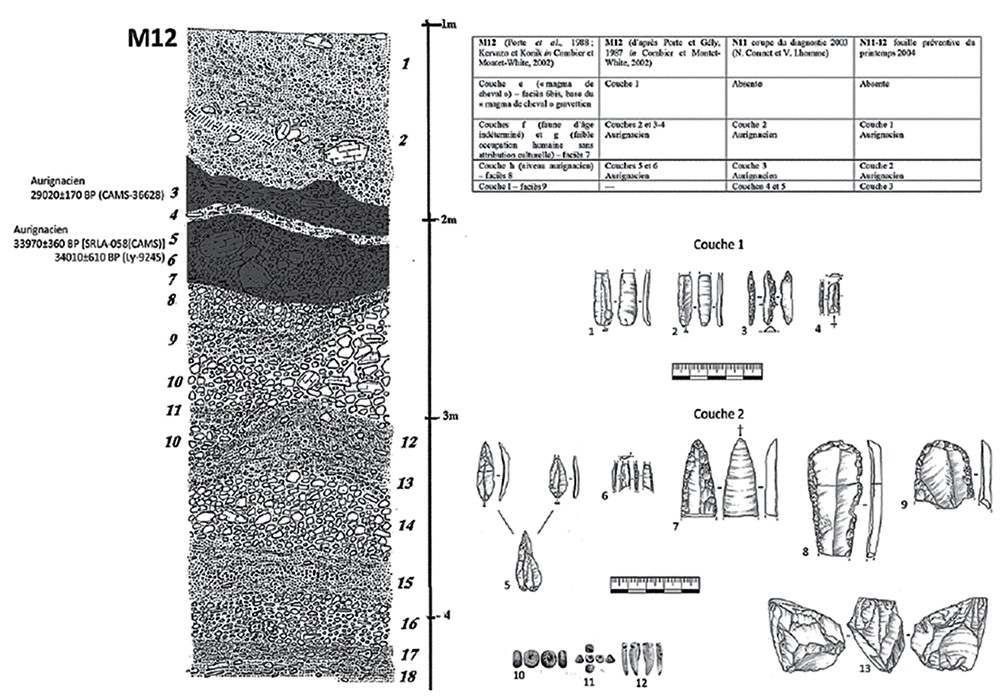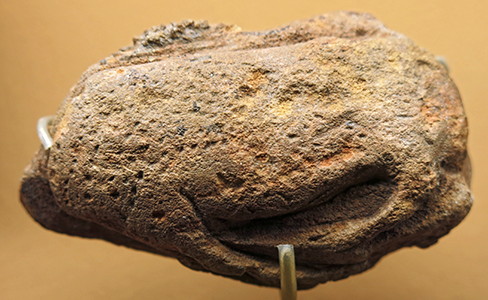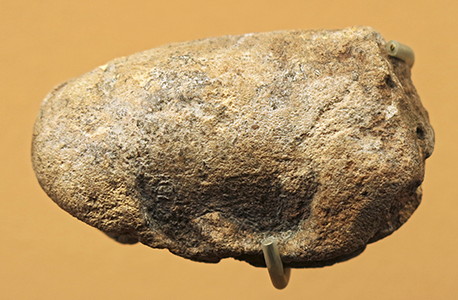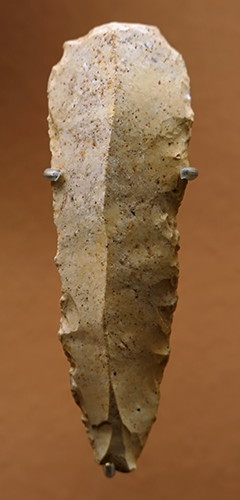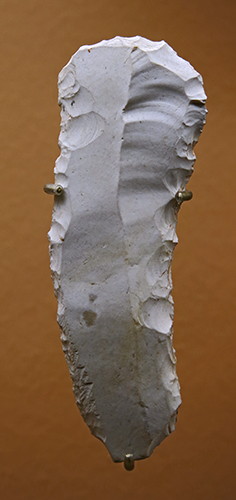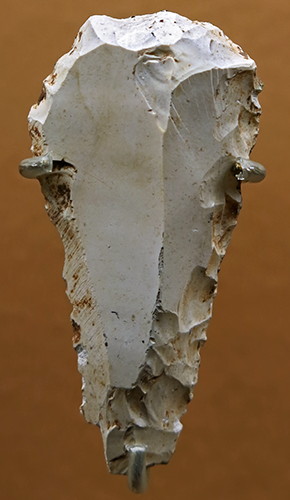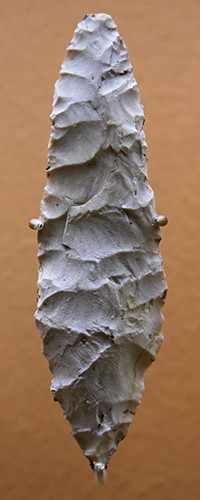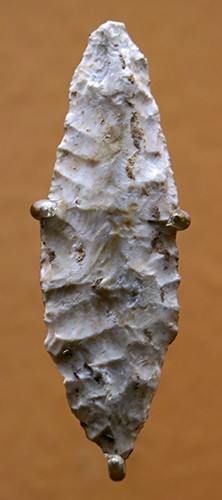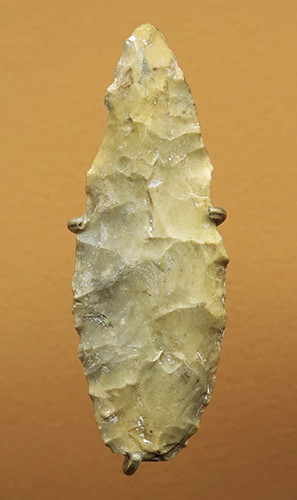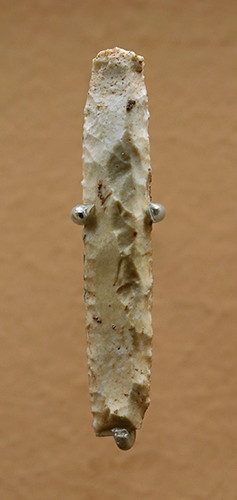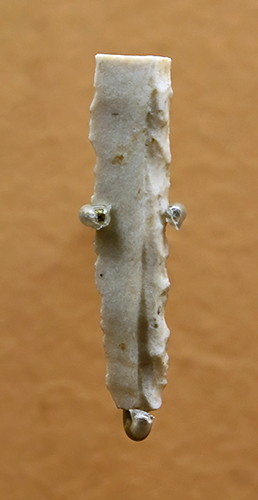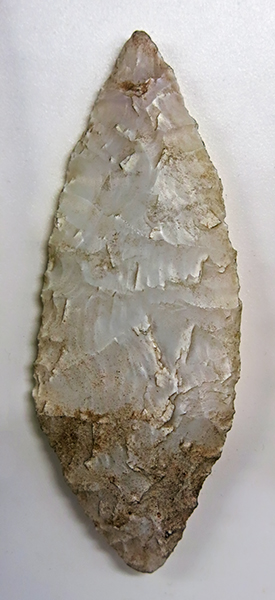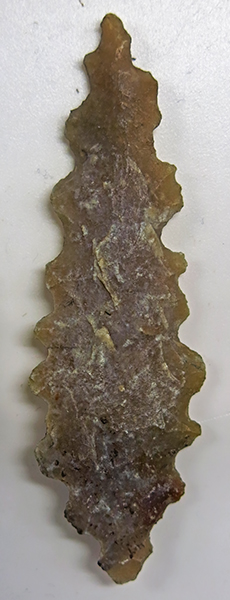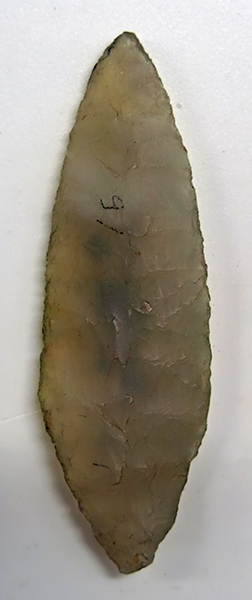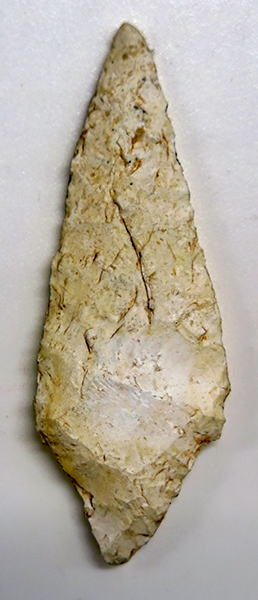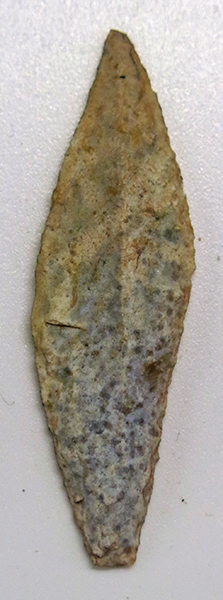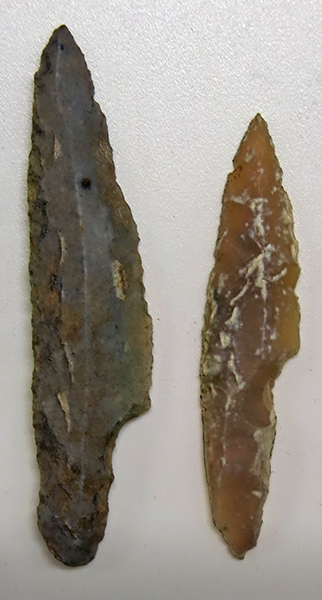The Solutrean - the peak of stone tools workmanship

Limestone cliffs near Solutré, at the foot of which is the celebrated archaeological site of Crôt du Charnier.
Photo: Yelkrokoyade (2009)
The Solutrean takes its name from the Crôt du Charnier site in Solutré-Pouilly, in Saône-et-Loire. During all the upper Paleolithic, Solutré was a site which specialised in the hunting of horses, where prehistoric men returned periodically. It does not include living areas occupied for long periods, but there are specialised areas of activity, especially the processing of game after the hunt.Text above: Musée d'Archeologie Nationale et Domaine, St-Germain-en-Laye
Some tools - pointes à face plane, laurel leaves, shouldered points - were made by a sophisticated retouch that was obtained by a new technique called pressure flaking, on flint which had been heat treated to make it much more workable.
To make these lanceolate (leaf-shaped) points, the Solutrean people developed an exceptionally deft technique of pressure flaking – pressing with a soft tool such as an antler tine or bone point – instead of striking directly with a soft or hard hammer. There are other examples of this technique in prehistoric implements but the Solutrean people raised this technique to an artform where their arrowheads and spearpoints were as efficient as possible and like many optimum designs - an aircraft's wing, say – they also exhibit a form of beauty.Text above: http://www.stoneagetools.co.uk/solutrean-theory.htm
The Solutrean technology is largely isolated in the prehistoric record. It was preceded by an industry based on Acheulian bifaces and scraper tools and it was succeeded by the widespread adoption of microlith technology in the Upper Palaeolithic and Mesolithic periods. It was the dominant technology for the relatively short space of time from 21 000 years ago to circa 15 000 years ago.
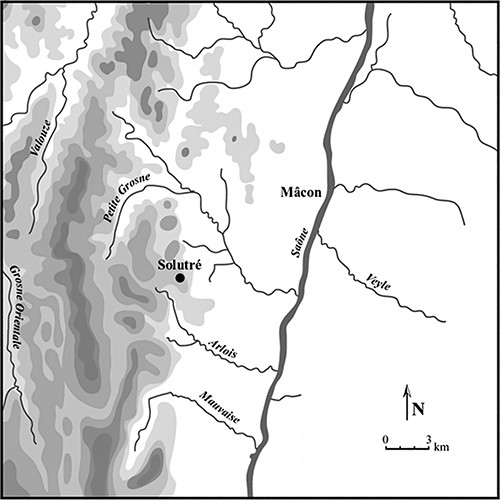
Locality of Solutré.
The earliest excavations at Solutré began in 1866 under the direction of Adrien Arcelin and Henri Testot-Ferry, with efforts focused on the so-called 'horse magma', a layer of accreted horse bones, and several foyers du renne, hearths ostensibly of the l’age du renne, or the Solutrean.
Between 1873 and 1895, Arcelin, with the aid of Abbé Ducrost, conducted further excavations at the site, which identified three successive culturally distinct layers of occupation, Solutrean, Gravettian, and an unattributed basal stratum, which was subsequently defined in 1907 by Abbé Breuil as Aurignacian.
Continued work in the 20th century by the University of Lyon and Jean Combier on behalf of the CNRS have combined to produce a fairly fine-grained understanding of the complex nature of over 20 000 years of occupation and activity at the site of Solutré.
Photo and text: Pestle et al. (2006)
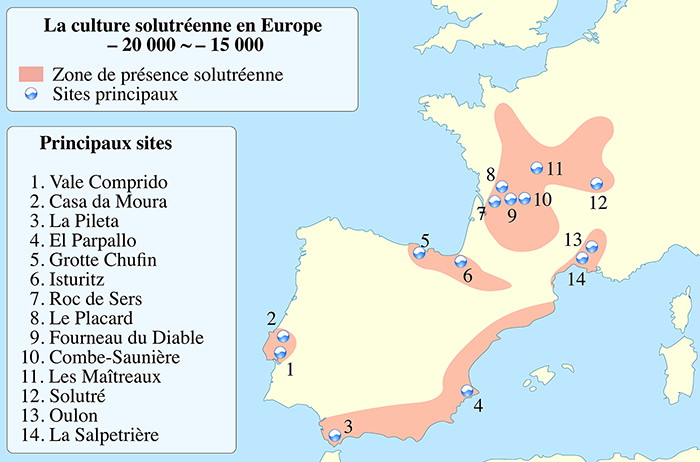
The Solutrean in Western Europe.
Photo: © Sémhur / Wikimedia Commons / CC-BY-SA-3.0 (or Free Art License)
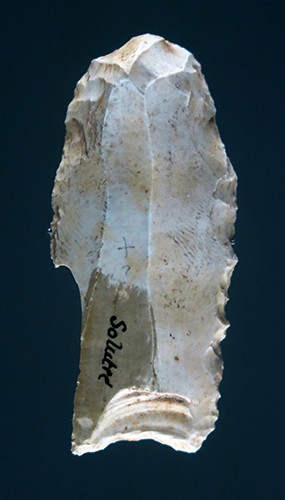
Grattoir-burin.
Provenance: Solutré
Photo: Don Hitchcock 2015
Source: Original, Muséum de Toulouse, or Muséum d'Histoire Naturelle de la ville de Toulouse, MHNT
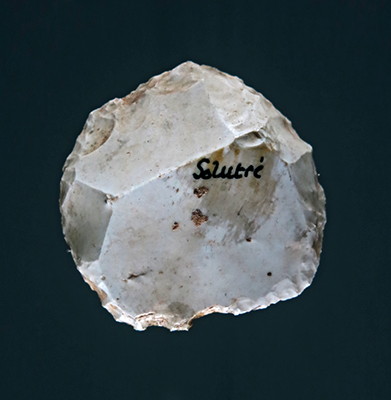

(left) Double grattoir.
(right) Grattoir made on a retouched blade.
Provenance: Solutré
Photo: Don Hitchcock 2015
Source: Original, Muséum de Toulouse, or Muséum d'Histoire Naturelle de la ville de Toulouse, MHNT
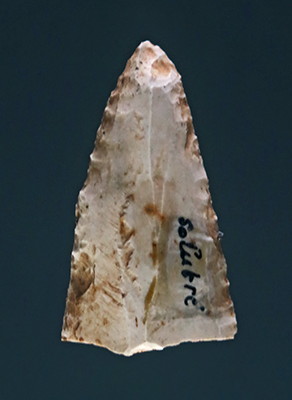

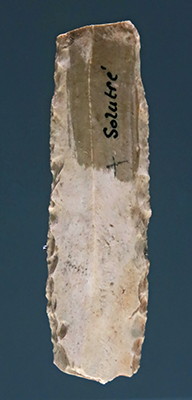
Retouched blades.
Provenance: Solutré
Photo: Don Hitchcock 2015
Source: Original, Muséum de Toulouse, or Muséum d'Histoire Naturelle de la ville de Toulouse, MHNT
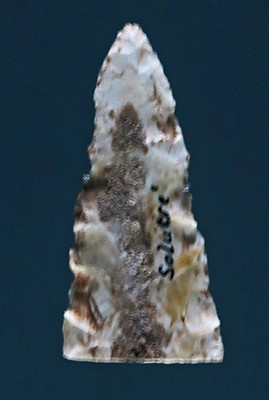

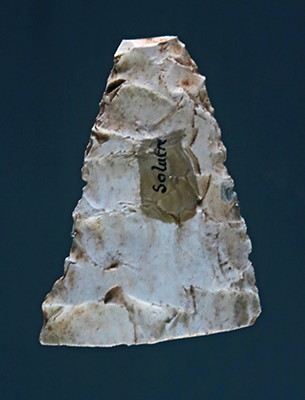
Tips of laurel leafed blades.
Provenance: Solutré
Photo: Don Hitchcock 2015
Source: Original, Muséum de Toulouse, or Muséum d'Histoire Naturelle de la ville de Toulouse, MHNT

Small laurel leafed blade.
Provenance: Solutré
Photo: Don Hitchcock 2015
Source: Original, Muséum de Toulouse, or Muséum d'Histoire Naturelle de la ville de Toulouse, MHNT
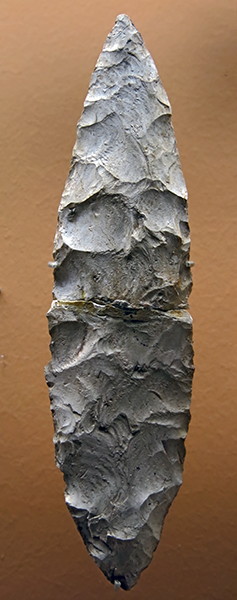
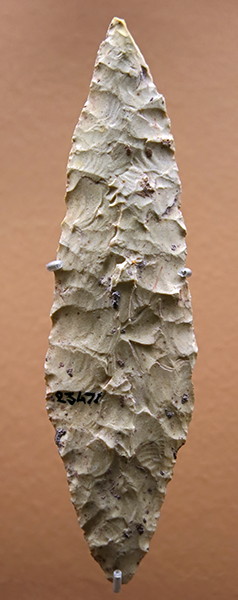
Solutrean Laurel leaf points.
Period: Solutrean
Provenance: Solutré, Crôt du Charnier at Solutré-Pouilly, in Saône-et-Loire.
Photo: Don Hitchcock 2015
Source: Original, Musée d'Archeologie Nationale et Domaine, St-Germain-en-Laye
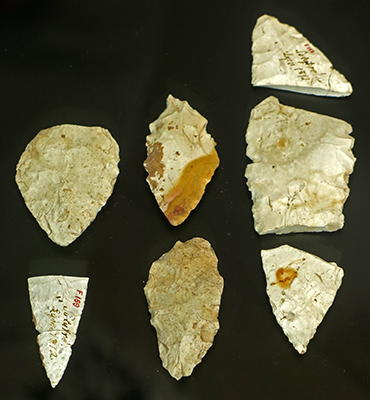
Tools from Solutré, Solutrean, 18 000 BP.
Photo: Don Hitchcock 2014
Source and text: Original, Københavns (Copenhagen) Museum, National Museum of Denmark
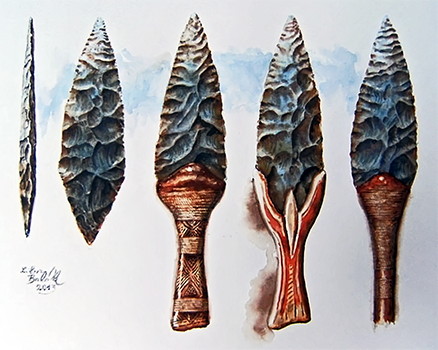
Libor Balák is a highly talented artist who makes a specialty of depicting life in Palaeolithic times. His vast knowledge and ability to communicate his understanding in a graphical manner makes his work very useful indeed to students of the Palaeolithic.
The second picture from the right shows a tool hilt found in the Pekárna cave in Moravia . Because many of the laurel-leaf points were very fragile, large and thin, they may have been used as knives rather than spear points, with the knife usually kept ensheathed in a scabbard for protection and ease of use.
The prestige and appearance of the tool was probably more important than the fact that the blade was quite fragile. It is likely that the very large and thin laurel-leaf blades were more status symbols than useful tools.
Shown here are two other possibilities for the design of handles for the Solutrean laurel leaf points.
Photo: © Libor Balák
Source and text adapted from: http://www.anthropark.wz.cz/solutren_a.htm
| Relations and Subdivisions of Solutrean Culture | |||
|---|---|---|---|
| Name | Characteristics | Sites | |
| Lower (Early) Magdalenian | Prototypes of bone harpoons. Beginnings of animal sculpture. Absence of any trace of the laurel-leaf spear heads of Solutrean times. |
||
| Upper (Late) Solutrean | Typical shouldered points (pointes à cran)- elongate flakes worked on one or both sides and notched. Small laurel-leaf spear heads. Bone javelin points, awls, and needles, very finely worked. |
Placard, Lacave | |
| Middle (High) Solutrean | Large 'laurel-leaf' spear heads worked on both sides. Climax of Solutrean flint industry. |
Placard | |
| Lower (Proto-) Solutrean | Primitive 'laurel-leaf' and 'willow-leaf' spear heads, most of them worked on only one side. | Grotte du Trilobite | |
| Transition from Aurignacian | Pedunculate spear heads (pointes à soie) of primitive Font Robert type. Climax of human sculpture. |
||
The type station of the Solutrean culture is the great open-air camp of Solutré, near the Saône, sheltered on the north by a steep ridge and with a fine, sunny exposure toward the south. The traces of this great camp, which is the largest thus far discovered in western Europe, cover an area 300 feet square and are situated within a short distance of a good spring of water.Text above: Osborn (1919)
As explored, in 1866, by Arcelin, Ferry, and Ducrost, this station had already been occupied in Aurignacian times; and two sections, taken at two different points, showed the deposits of the old camp to be from 22 to 26 feet in thickness, representing superposed Aurignacian and Solutrean fire-hearths with thick layers of intermediate debris.
In the Aurignacian level is found the vast accumulation of the bones of horses which first brought the site to the attention of archaeologists. In the middle Solutrean levels great fireplaces are found with flint utensils and the remains of abundant feasts among the charred debris. The fauna includes the wolf, the fox, the hyena, both the cave and the brown bear, the badger, the rabbit, the stag, wild cattle, and two characteristic northern forms- the woolly mammoth and the reindeer; the remains of the last are the most abundant in the ancient hearths.
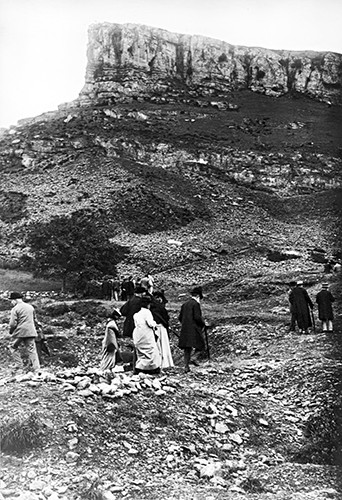
Excavations in the 19th Century.
Excavations at the foot of the rock started in 1866, in a place known as the 'Crôt du Charnier', on a protrusion of horse bones, which no one imagined at the time would date to prehistory, as archeology was just emerging as a scientific field at the time.
The zone of Upper Paleolithic sites was soon discovered by Henry Testot-Ferry. Numerous flint tools were found, including spear-points, knives and scrapers, and also a large number of bones, mainly from reindeer, but also from horses, mammoths, wolves, and cave lions.
Testot-Ferry and Adrien Arcelin decided to see if they could determine scientifically how large the deposit was that they had brought to light, and to examine with great care the remains that they had recovered. The challenge was to understand the arrangement of stratigraphic areas of the site, which would be the basis for establishing a chronology.
In 1868, the preferred scientific hypothesis viewed the site as a hunting station. The two discoverers called on specialists and presented their work at conferences. Solutré was revealed as one of the greatest prehistoric sites in France.
In 1872, Gabriel de Mortillet, one of the most important prehistorians of his time, decided to name prehistoric periods after sites where they were particularly well presented. Thus the term 'Solutrean' was born.
Photo: Unknown
Source: http://rochedesolutre.com/histoire-du-site/
Text: Wikipedia

Excavations 1910 - 1912.
Numerous excavations were conducted after Gabriel de Mortillet defined the period as Solutrean in 1872. The excavation site remains protected, and partially unexplored, to this day.
The height of the sites in relation to the flood plain was the most important factor for human habitation. Providing food and shelter for nomadic groups, the foot of the rock, strewn with debris, also afforded hunters the opportunity to develop traps.
Photo: Unknown, postcard
Source: http://www.befr.ebay.be/
Text: Wikipedia

The bone-laden 'magma' can be explained by the fact that the site was used by four great palaeolithic civilisations over the 25 000 years from 37 000 to 12 000 BP, an extremely long time period.
The use of this site was therefore devoted to hunting activity, butchering and drying meat, while the neighbouring Rock of Vergisson was a site for habitation. The material found at Solutré was therefore linked with hunting; many tools were found including flints in the shape of laurel leaves which are characteristic of Solutrean culture.
Photo: Verry et al. (2009)
Text: Wikipedia
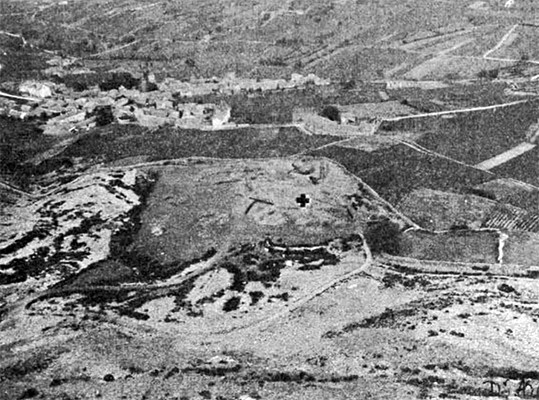
The type station of the Solutrean culture is the great open-air camp of Solutré, near the Saône, sheltered on the north by a steep ridge and with a fine, sunny exposure toward the south. The traces of this great camp cover an area 100 metres square and are situated within a short distance of a good spring of water.
As explored, in 1866, by Arcelin, Ferry, and Ducrost, this station had already been occupied in Aurignacian times; and two sections, taken at two different points, showed the deposits of the old camp to be from 7 to 8 metres in thickness, representing superposed Aurignacian and Solutrean hearths with thick layers of intermediate debris.
In the Aurignacian level is found the vast accumulation of the bones of horses commonly known as 'the magma'. In the middle Solutrean levels great fireplaces are found with flint utensils and the remains of abundant feasts among the charred debris.
The fauna includes the wolf, the fox, the hyena, both the cave and the brown bear, the badger, the rabbit, the stag, wild cattle, and two characteristic northern forms- the woolly mammoth and the reindeer. Reindeer remains are the most abundant in the ancient hearths.
Photo and text: Osborn (1919)

The lower layers at Solutré.
(above) Stratigraphy, Breuil (1909).
(left) Solutré site plan, the grey zones represent areas where the lower layers occur, Combier 1955.
(right) Atypical backed knives from the lower layers, Combier 1955.
Source and text: Floss et al. (2013)
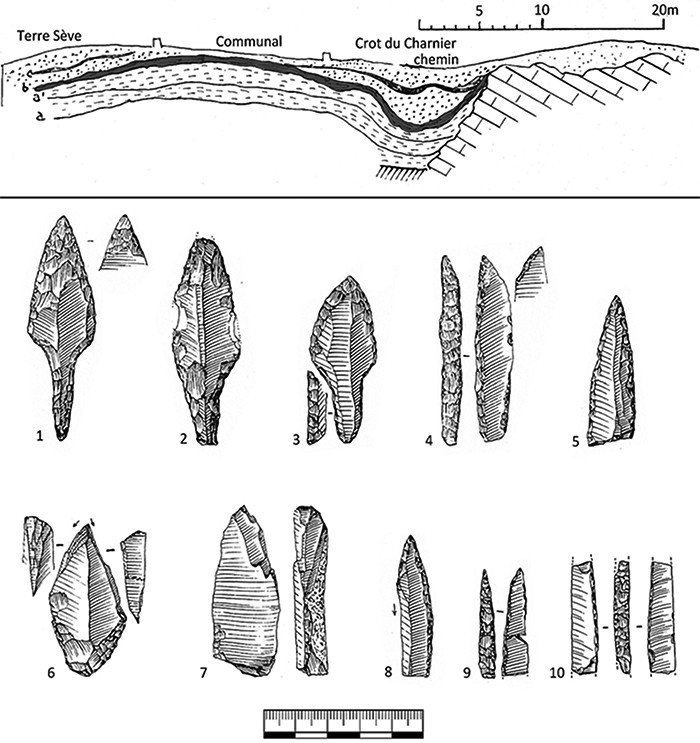
Solutré Gravettian.
Above, stratigraphical sequence belonging to the Arcelin excavations containing layer b representing the famous magma de cheval, Combier 1955. Below, Gravettian
lithic industry (Combier 1955, fig. 22 to 24)
1 to 3: Font-Robert points
4 and 5: Gravette points
6: Polyhedral burin
7: Dihedral burin.
8 to 10: Gravette points
Source and text: Floss et al. (2013)
Solutré Aurignacian.
(left part of image) Stratigraphical sequence in the sector M 12, Combier et Montet-White (2002).
(right upper part of image) Stratigraphical correlation between the sectors M 12 and N 11-12, Connet et al. (2005).
(right lower part of image) examples of the lithic industry and of elements of personal decoration from layers 1 and 2, Connet et al. (2005)
1 to 4: Bladelets, partially retouched from layer 1
5: Two refitted bladelets emerging from carinated pieces
6: Dufour bladelet
7: Aurignacian blade
8 and 9: End-scrapers
10: Disc shaped bead made of ivory
11: Basket shaped bead made of ivory
12: Notched marmot incisor
13: Bladelet core
Source and text: Floss et al. (2013)
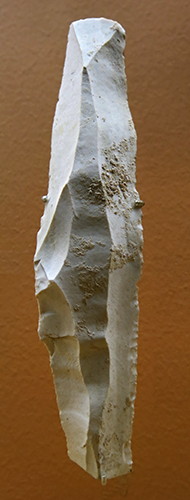
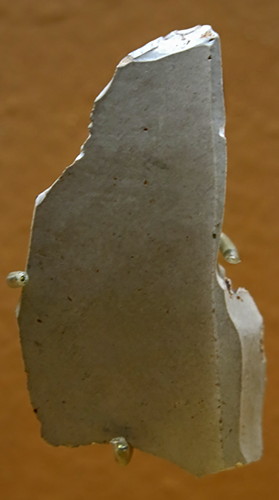
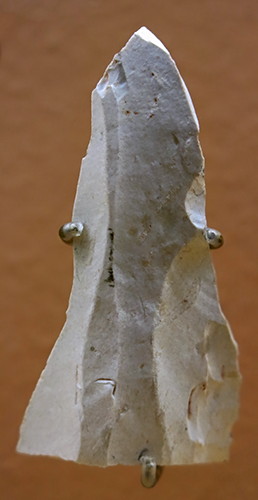
(left) Blade.
(centre and right) Burins.
Period: Aurignacian/Gravettian
Provenance: Solutré, Crôt du Charnier at Solutré-Pouilly, in Saône-et-Loire.
Photo: Don Hitchcock 2015
Source: Original, Musée d'Archeologie Nationale et Domaine, St-Germain-en-Laye

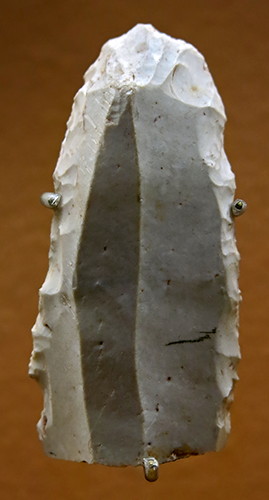
Grattoirs.
Period: Aurignacian/Gravettian
Provenance: Solutré, Crôt du Charnier at Solutré-Pouilly, in Saône-et-Loire.
Photo: Don Hitchcock 2015
Source: Original, Musée d'Archeologie Nationale et Domaine, St-Germain-en-Laye

Indecipherable engraving, marly limestone.
Period: Solutrean
Provenance: Solutré, Crôt du Charnier at Solutré-Pouilly, in Saône-et-Loire.
Photo: Don Hitchcock 2015
Source: Original, Musée d'Archeologie Nationale et Domaine, St-Germain-en-Laye
Resting reindeers sculpted on pebbles.
( this such an unusual subject for a sculpture, and the two are so similar in both the material used and the way the figure is carved, that I believe it is likely that it was a single artist who sculpted both these artefacts - Don )
Period: Solutrean
Provenance: Solutré, Crôt du Charnier at Solutré-Pouilly, in Saône-et-Loire.
Photo: Don Hitchcock 2015
Source: Original, Musée d'Archeologie Nationale et Domaine, St-Germain-en-Laye
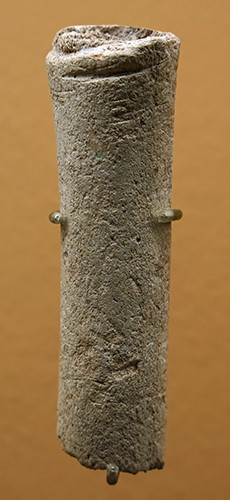
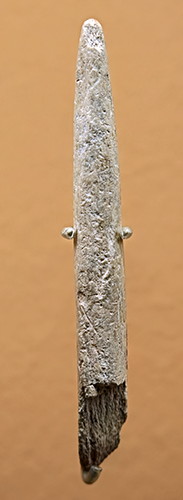
(left) Baguette, a cylinder of uncertain use and material in this case.
(right) Spearpoint.
Period: Solutrean
Provenance: Solutré, Crôt du Charnier at Solutré-Pouilly, in Saône-et-Loire.
Photo: Don Hitchcock 2015
Source: Original, Musée d'Archeologie Nationale et Domaine, St-Germain-en-Laye

(left and above) Grattoirs.
Period: Solutrean
Provenance: Solutré, Crôt du Charnier at Solutré-Pouilly, in Saône-et-Loire.
Photo: Don Hitchcock 2015
Source: Original, Musée d'Archeologie Nationale et Domaine, St-Germain-en-Laye

(left and above) Laurel leaf points.
Period: Solutrean
Provenance: Solutré, Crôt du Charnier at Solutré-Pouilly, in Saône-et-Loire.
Photo: Don Hitchcock 2015
Source: Original, Musée d'Archeologie Nationale et Domaine, St-Germain-en-Laye


Laurel leaf points.
(left) 102 mm x 25 mm, MAN54882, Vitrine paléolithique supérieur, chasse et pêche, pièce n° 14
(right) 60 mm x 18 mm, MAN54907, Vitrine paléolithique supérieur, chasse et pêche, pièce n° 15
Period: Solutrean
Provenance: Not recorded on the museum card or online catalog
Photo: Don Hitchcock 2015
Source: Original, Musée d'Archeologie Nationale et Domaine, St-Germain-en-Laye
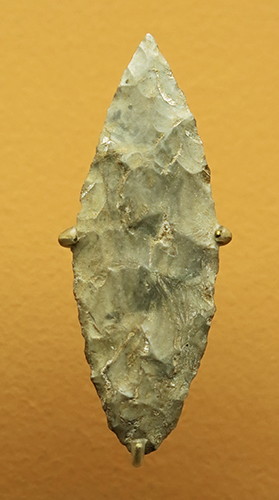
(left and above) Laurel Leaf points.
Period: Solutrean
Provenance: Isturitz
Photo: Don Hitchcock 2015
Source: Original, Musée d'Archeologie Nationale et Domaine, St-Germain-en-Laye
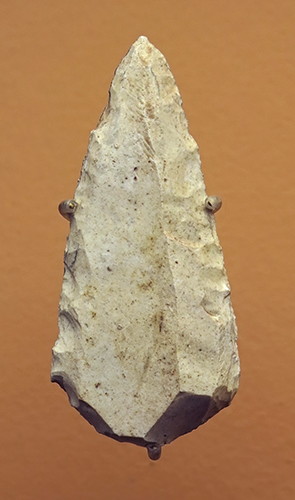
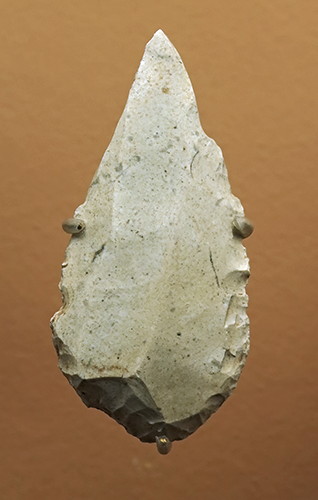
Grattoir (left) and grattoir-burin (right).
Period: Solutrean
Provenance: Isturitz
Photo: Don Hitchcock 2015
Source: Original, Musée d'Archeologie Nationale et Domaine, St-Germain-en-Laye
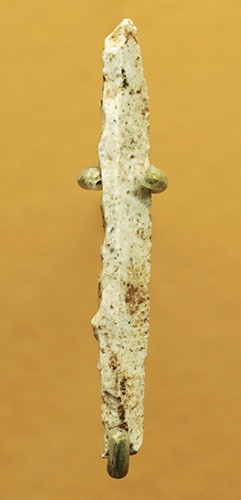
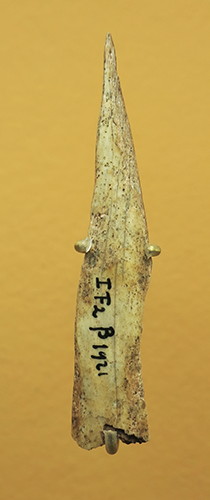

(left) Backed blade.
(centre) Poinçon or awl.
(right) Pointe de sagaie à base raccourcie, or spear point with a shortened base.
Period: Solutrean
Provenance: Isturitz
Photo: Don Hitchcock 2015
Source: Original, Musée d'Archeologie Nationale et Domaine, St-Germain-en-Laye

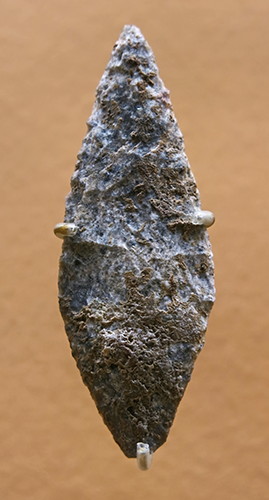
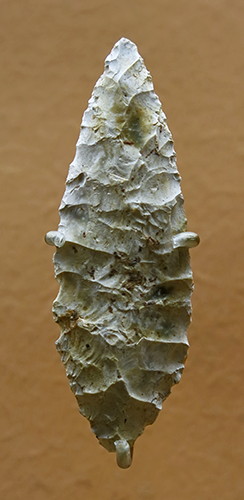
Leaf points.
Period: Solutrean
Provenance: Badegoule
Photo: Don Hitchcock 2015
Source: Original, Musée d'Archeologie Nationale et Domaine, St-Germain-en-Laye
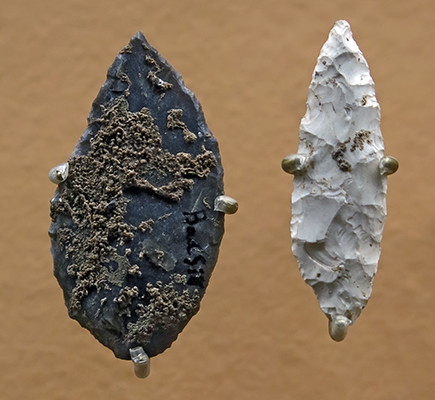
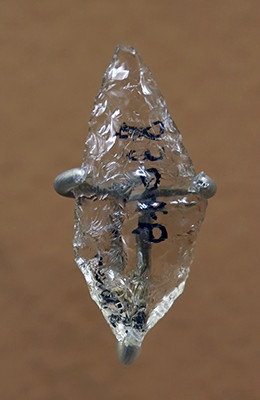
Small leaf points.
The rock crystal leaf point on the right is a demonstration of the skill of the knapper.
Quartz is not nearly as easy to work as flint, as is obvious here, where the shape is not as symmetrical as in comparable flint leaf points. Heat treatment is not effective, and the knapper needs to use wood instead of stone as a hammer'stone'.
The results can be beautiful, but rock crystal is more suitable for status objects and a challenge for the knapper than for useable tools.
Period: Solutrean
Provenance: Badegoule
Photo: Don Hitchcock 2015
Source: Original, Musée d'Archeologie Nationale et Domaine, St-Germain-en-Laye
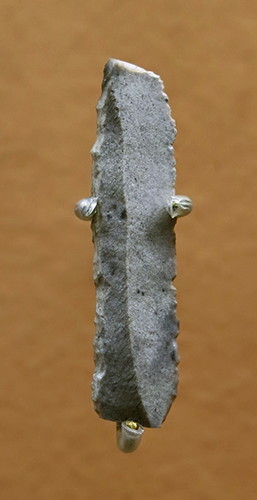
Backed blades.
Period: Solutrean
Provenance: Badegoule
Photo: Don Hitchcock 2015
Source: Original, Musée d'Archeologie Nationale et Domaine, St-Germain-en-Laye
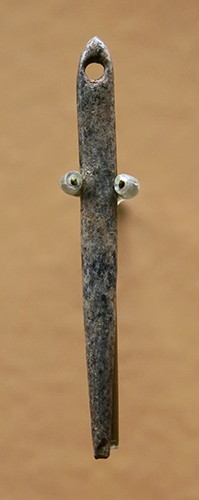
Eyed needle.
Period: Solutrean
Provenance: Badegoule
Photo: Don Hitchcock 2015
Source: Original, Musée d'Archeologie Nationale et Domaine, St-Germain-en-Laye
Pointes à Face Plane
The following definitions for Pointes à face plane are by the always sound and erudite Katzman, from his excellent Aggsbachs blog, in this case the page http://www.aggsbach.de/2017/06/point-a-face-plane-from-laugerie-haute/:
Type A: Nearly or fully symmetrical, pointed on both ends, or on only one end, which can be occasionally rounded. Upper face covered with flat retouches. Lower face plain or retouched over a limited part of its surface.
Type B: The most typical points at Laugerie: teardrop shaped or déjeté ('skewed') usually to the right. Much of the upper face retouched along the left side of the median ridge. Occasionally the upper face is entirely retouched. Bulb at the base may have been removed by retouches.
Type C: 'Chatelperron- like', slightly curved and made on a long blade. The retouches are concentrated on one side of the median spine of the upper face. Bulb at the base may have been removed by retouches.
Type D: Broad and heavy, made on a flake with flat retouching covering the upper face and parts of the lower face. 'Mousterian-like' and found throughout the Solutrean and not only in the earlier phases. Type-site: Badegoule.
Type E: essentially only pointed blades. Single or double tipped. Flat retouching concentrated around the tip.
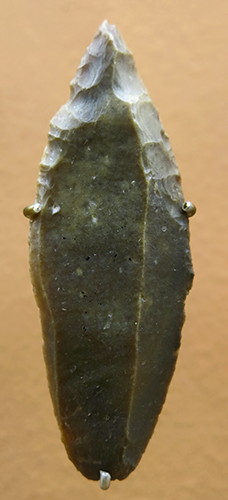
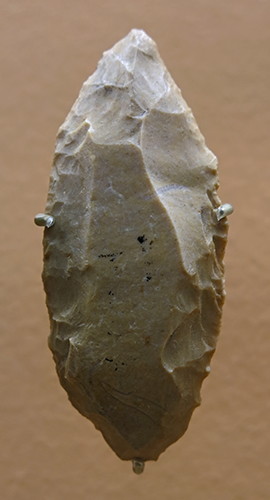
Pointes à face plane.
( these appear to be type E, essentially only pointed blades, single tipped with flat retouching concentrated around the tip - Don )
Period: Solutrean
Provenance: Badegoule
Photo: Don Hitchcock 2015
Source: Original, Musée d'Archeologie Nationale et Domaine, St-Germain-en-Laye
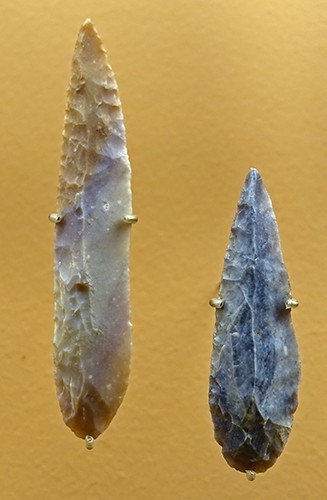
Pointes à face plane.
( these appear to be type B, teardrop shaped, with much of the upper face retouched along the left side of the median ridge - Don )
Period: Solutrean
Provenance: Unknown
Photo: Don Hitchcock 2018
Source: Original, Musée d'Archeologie Nationale et Domaine, St-Germain-en-Laye

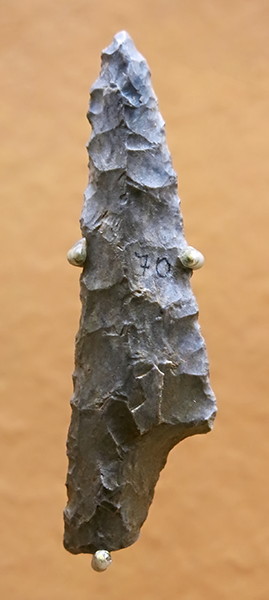

Pointes à cran, shouldered points.
Period: Solutrean
Provenance: Badegoule
Photo: Don Hitchcock 2015
Source: Original, Musée d'Archeologie Nationale et Domaine, St-Germain-en-Laye

Pointes à cran, shouldered points.
Period: Solutrean
Provenance: Unknown
Photo: Don Hitchcock 2018
Source: Original, Musée d'Archeologie Nationale et Domaine, St-Germain-en-Laye
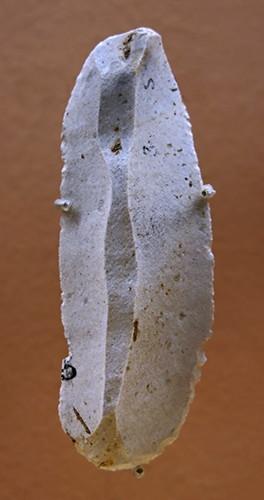
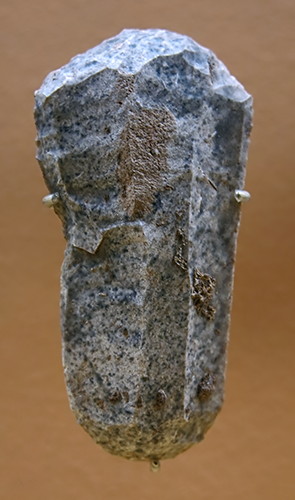
(left) Grattoir, scraper.
(right) Double grattoir.
Period: Solutrean
Provenance: Badegoule
Photo: Don Hitchcock 2015
Source: Original, Musée d'Archeologie Nationale et Domaine, St-Germain-en-Laye
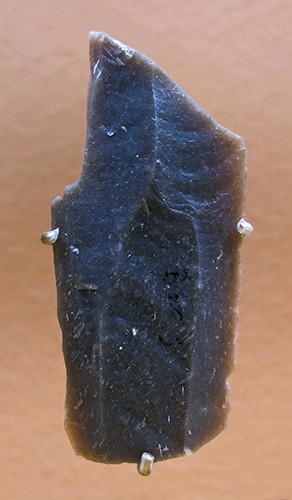
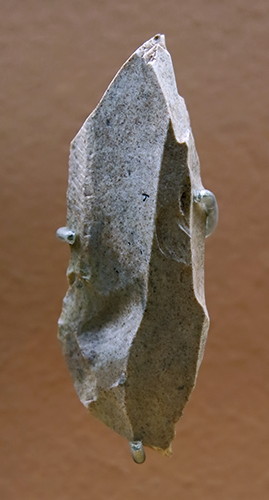
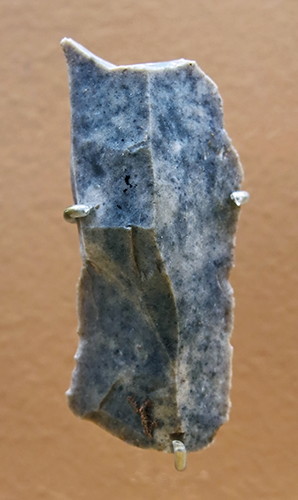
Burins.
Period: Solutrean
Provenance: Badegoule
Photo: Don Hitchcock 2015
Source: Original, Musée d'Archeologie Nationale et Domaine, St-Germain-en-Laye

Perçoir or awl.
Used to make holes in items such as leather.
Period: Solutrean
Provenance: Badegoule
Photo: Don Hitchcock 2015
Source: Original, Musée d'Archeologie Nationale et Domaine, St-Germain-en-Laye

Spear point with a simple base.
Period: Solutrean
Provenance: Badegoule
Photo: Don Hitchcock 2015
Source: Original, Musée d'Archeologie Nationale et Domaine, St-Germain-en-Laye

Tiny Ammonite shell fossil, with a convenient pre-existing hole, used as a pendant.
Some ammonite fossils, like this one, bear intricate patterned details on their outer surface called Sutures. These are located beneath the external shell wall, but are often visible if the fossil has been subject to weathering or artificial polishing.
These patterns mark where the walls of the chambers, the septa, meet the outer wall of the ammonite shell. The bulk of each septum is relatively flat, but becomes folded where it meets the outer shell.
This method of construction is thought to have provided strength to the shell when diving to deeper depths. Suture patterns are very useful for distinguishing different species of ammonite.
Period: Solutrean
Provenance: Badegoule
Photo: Don Hitchcock 2015
Source: Original, Musée d'Archeologie Nationale et Domaine, St-Germain-en-Laye
Additional text: http://www.discoveringfossils.co.uk/ammonites.htm
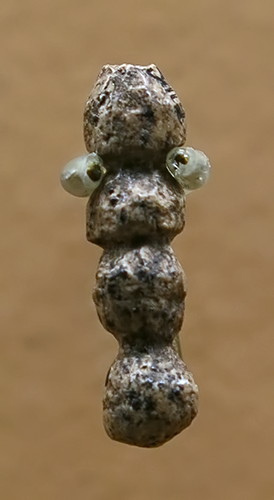
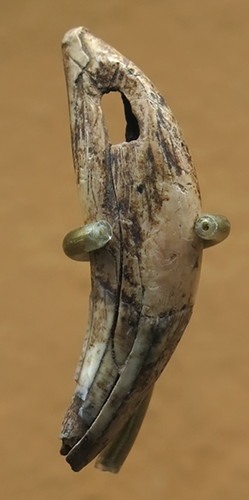
(left) Carved pendant.
(right) Pierced carnivore tooth.
Period: Solutrean
Provenance: Badegoule
Photo: Don Hitchcock 2015
Source: Original, Musée d'Archeologie Nationale et Domaine, St-Germain-en-Laye
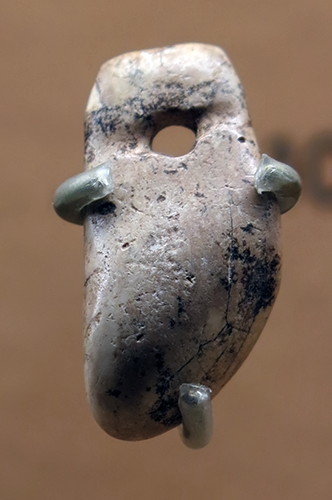
Pierced deer canine.
( the horizontal groove as a result of wear on this tooth might mean that it was originally part of a necklace, with a double cord crisscrossing through each object in the necklace, possibly also knotted on each side of each of the beads or teeth - Don )
Period: Solutrean
Provenance: Badegoule
Photo: Don Hitchcock 2015
Source: Original, Musée d'Archeologie Nationale et Domaine, St-Germain-en-Laye

Laurel leaf blade of prodigious length/width ratio.
Period: Solutrean
Provenance: Le Placard, layers F and G
Photo: Don Hitchcock 2014
Source: Original, Musée d'Archeologie Nationale et Domaine, St-Germain-en-Laye
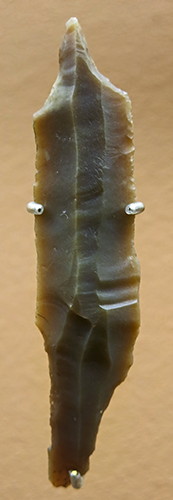

(left) Drill or awl
(right) Burin
Period: Solutrean
Provenance: Le Placard, layers F and G
Photo: Don Hitchcock 2015
Source: Original, Musée d'Archeologie Nationale et Domaine, St-Germain-en-Laye
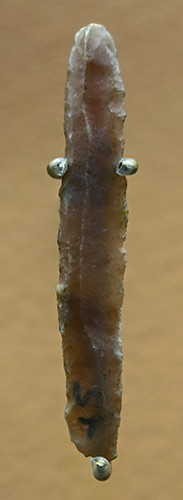

Backed blades.
Period: Solutrean
Provenance: Le Placard, layers F and G
Photo: Don Hitchcock 2015
Source: Original, Musée d'Archeologie Nationale et Domaine, St-Germain-en-Laye



(left) Poinçon, awl, with engravings.
(centre) Spear point with a simple base.
(right) Spear point (?), engraved.
Period: Solutrean
Provenance: Le Placard, layers F and G
Photo: Don Hitchcock 2015
Source: Original, Musée d'Archeologie Nationale et Domaine, St-Germain-en-Laye
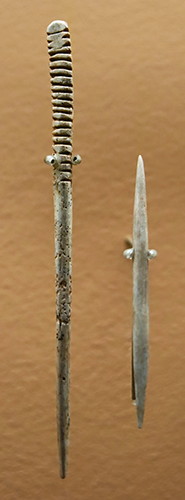
(left) Hairpin, (right) Double ended point.
Period: Solutrean
Provenance: Le Placard, layers F and G
Photo: Don Hitchcock 2015
Source: Original, Musée d'Archeologie Nationale et Domaine, St-Germain-en-Laye
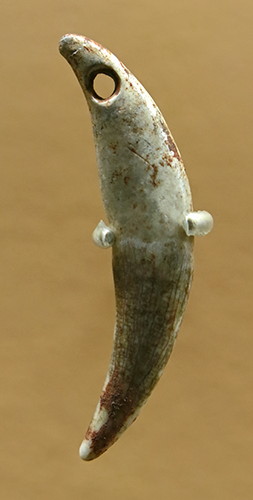
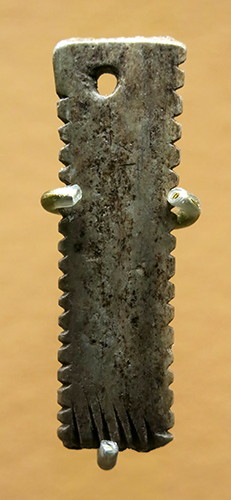

(left and centre) Pendants used as jewellery, originals.
(right) Engraved bone, facsimile.
Period: Solutrean
Provenance: Le Placard, layers F and G
Photo: Don Hitchcock 2015
Source: Original, Musée d'Archeologie Nationale et Domaine, St-Germain-en-Laye
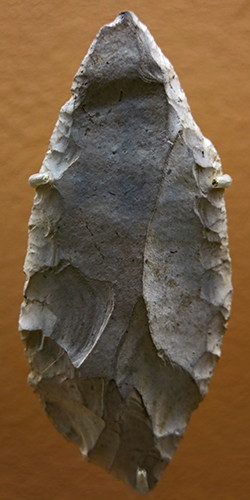
Laurel leaf point.
Period: Solutrean
Provenance: Le Placard, layers F and G
Photo: Don Hitchcock 2015
Source: Original, Musée d'Archeologie Nationale et Domaine, St-Germain-en-Laye

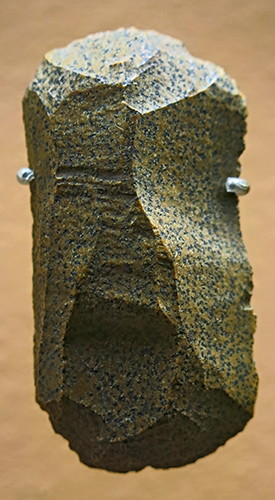
(left) Grattoir
(right) Double Grattoir
Period: Solutrean
Provenance: Le Placard, layers F and G
Photo: Don Hitchcock 2015
Source: Original, Musée d'Archeologie Nationale et Domaine, St-Germain-en-Laye
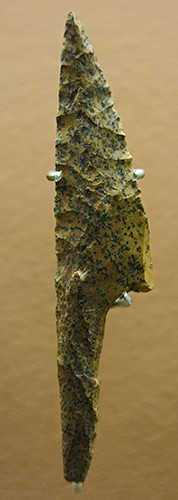


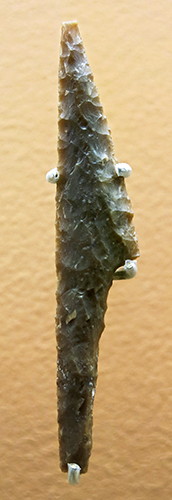
Shouldered points.
( My favourite of all of these shouldered points is the one on the far left. The technique and form is exemplary, the zenith of the art. The flint used is unique and fascinating, the same as one of the grattoirs above.
Readers should realise that these tiny tools were made with a full arsenal of skill and technique never before attained, of heat treatment of the flint and pressure flaking on an extremely small artefact. This is a tribute to the integrity and total control of the knapping process by the Solutrean master craftsmen, a level of ability which would never afterwards be approached for tens of thousands of years, until modern times in the 21st Century by dedicated knappers.
The very recent availability of relatively cheap optical fibre silica of superb quality has rejuvenated the creation of such objects. There are artisans in Europe and North America who are reinventing the entire genre, typically at the moment of knives of superb quality, with a wide range of colours, hafted with the finest workmanship - Don )
Period: Solutrean
Provenance: Le Placard, layers F and G
Photo: Don Hitchcock 2015
Source: Original, Musée d'Archeologie Nationale et Domaine, St-Germain-en-Laye


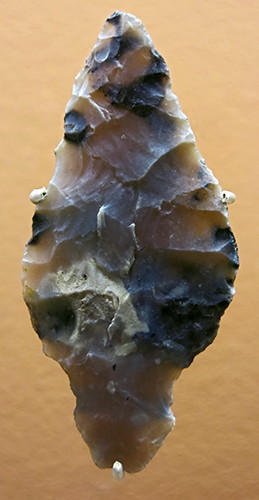
Laurel leaf points.
( note the point on the right of this group of three laurel leaf points. At first sight it looks ugly and ungainly. However it is one of the few laurel leaf points which may well have been designed for actual use in hunting, most look as though they are too thin and large to ever have been used in anger, they are more like status symbols. This one is shorter than the shouldered points above, though considerably wider.
If we look carefully, there is a 'handle' at the base which is obviously there to allow the point to be attached to a dart, with the use of sinew and birch bark glue. If we cover up that section with the black glue, and envisage the result on the end of a dart, a quite attractive and useful point is revealed - Don )
Period: Solutrean
Provenance: Le Placard, layers F and G
Photo: Don Hitchcock 2015
Source: Original, Musée d'Archeologie Nationale et Domaine, St-Germain-en-Laye
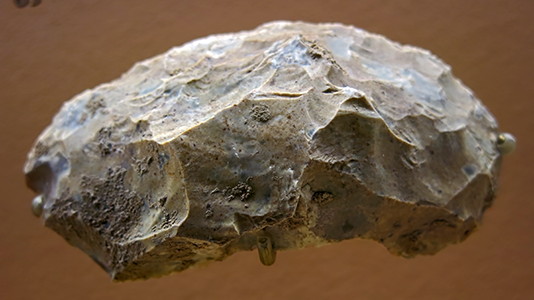
Racloir, or sideways scraper.
Period: Solutrean
Provenance: Le Placard, layers F and G
Photo: Don Hitchcock 2015
Source: Original, Musée d'Archeologie Nationale et Domaine, St-Germain-en-Laye
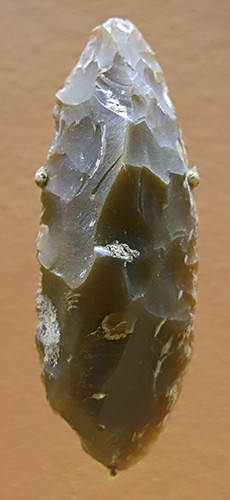
Double racloir, or sideways scraper, with two useable edges.
Period: Solutrean
Provenance: Le Placard, layers F and G
Photo: Don Hitchcock 2015
Source: Original, Musée d'Archeologie Nationale et Domaine, St-Germain-en-Laye
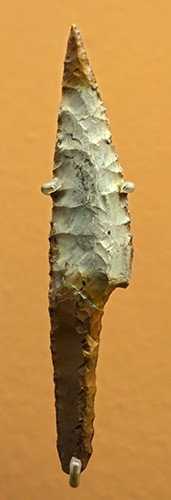
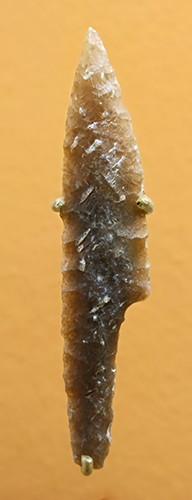

Shouldered points.
Period: Solutrean
(left): Solutrean shouldered point from la grotte du Placard.
Dimensions: 150 mm long, 80 mm wide, 5 mm thick.
Catalog MAN54913
(centre left):Solutrean shouldered point from la grotte du Placard.
Dimensions: 83 mm long, 16 mm wide, 5 mm thick.
Catalog MAN54911
(centre right): Solutrean shouldered point from la grotte du Placard.
Dimensions: 83 mm long, 15 mm wide, 3 mm thick.
Catalog MAN54911.3
(right): Solutrean shouldered point of unknown provenance.
Photo: Don Hitchcock 2015, 2018
Text: https://www.photo.rmn.fr
Source: Original, Musée d'Archeologie Nationale et Domaine, St-Germain-en-Laye

Laurel leaf point from la Grotte du Placard.
Period: Solutrean
Dimensions: length 191 mm, width 41 mm, thickness 6 mm.
Catalog: MAN54972
Photo: Don Hitchcock 2014
Source: Original, Musée d'Archeologie Nationale et Domaine, St-Germain-en-Laye
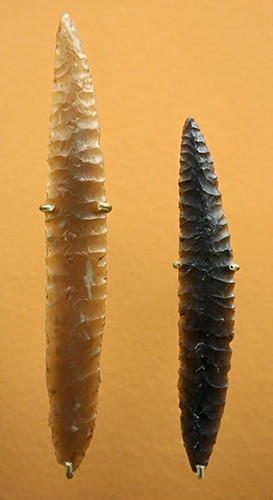
Feuilles de saule, Willow leaf points.
These superbly made blades, slim, with rounded ends and retouching on one side only, made their appearance in the late Solutrean.
Period: Solutrean
Left: Feuille de saule, Willow leaf point, from la grotte du Placard.
Dimensions: 132 mm long, 18 mm wide, 5 mm thick.
Catalog: MAN54879
Right: Feuille de saule, Willow leaf point, from la grotte du Placard.
Dimensions: 99 mm long, 16 mm wide, 4 mm thick.
Catalog MAN54879
Photo: Don Hitchcock 2014
Source: Original, Musée d'Archeologie Nationale et Domaine, St-Germain-en-Laye
Text: Adapted from Encyclopaedia Brittanica and https://www.photo.rmn.fr
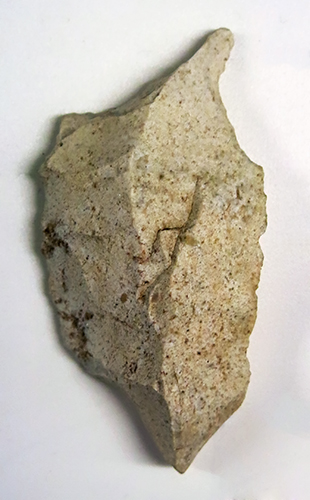
Perçoir, drill, Laussel, Marquay (24).
Period: Solutrean
Flint, Inv. no. 61.3.252
Photo: Don Hitchcock 2015
Source: Original, Musée d'Aquitaine à Bordeaux
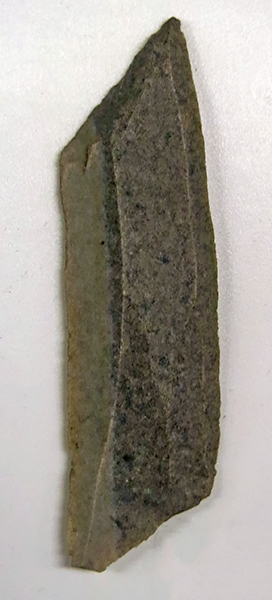
Lame tronquée, truncated blade, Laussel, Marquay (24).
( Blades are often truncated in order to make burins - Don )
Period: Solutrean
Flint, Inv. no. 61.3.239
Photo: Don Hitchcock 2015
Source: Original, Musée d'Aquitaine à Bordeaux
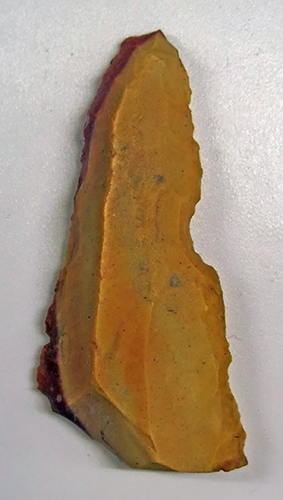
Encoche, notched tool, Les Jean-Blancs (Jamblancs), Bayac (24).
( These were used for shaping materials such as wood, as for example smoothing spear shafts - Don )
Period: Solutrean
Jasper, Inv. no. 60.476.13
Photo: Don Hitchcock 2015
Source: Original, Musée d'Aquitaine à Bordeaux
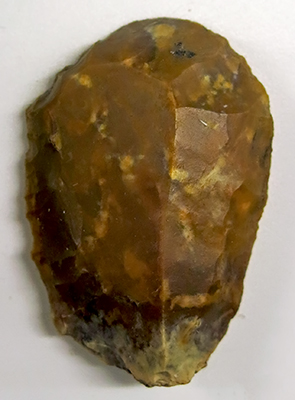
Grattoir, scraper, Les Jean-Blancs (Jamblancs), Bayac (24).
Period: Solutrean
Jasper, Inv. no. 60.476.12
Photo: Don Hitchcock 2015
Source: Original, Musée d'Aquitaine à Bordeaux
Laurel leaf points, Les Jean-Blancs (Jamblancs), Bayac (24), and Solutré, Solutré-Poyilly (71)
Period: Solutrean
Flint, Inv. no. 60.476.52, 54, 55, 60.871.2 and 3
Photo: Don Hitchcock 2015
Source: Original, Musée d'Aquitaine à Bordeaux
Laurel leaf points, Les Jean-Blancs (Jamblancs), Bayac (24), and Solutré, Solutré-Poyilly (71)
Period: Solutrean
Flint, Inv. no. 60.476.52, 54, 55, 60.871.2 and 3
Photo: Don Hitchcock 2015
Source: Original, Musée d'Aquitaine à Bordeaux
Pointes à face plane, Les Jean-Blancs (Jamblancs), Bayac (24)
( Flat faced points are points made on a blade with one side and base prepared for fitting to a spear shaft - Don )
Period: Solutrean
Flint, Inv. no. 60.476.33, 60.476.34
Photo: Don Hitchcock 2015
Source: Original, Musée d'Aquitaine à Bordeaux
Pointes à cran, shouldered points, Les Jean-Blancs (Jamblancs), Bayac (24)
Period: Solutrean
Flint, Inv. no. 60.476.30 (sic)
Photo: Don Hitchcock 2015
Source: Original, Musée d'Aquitaine à Bordeaux
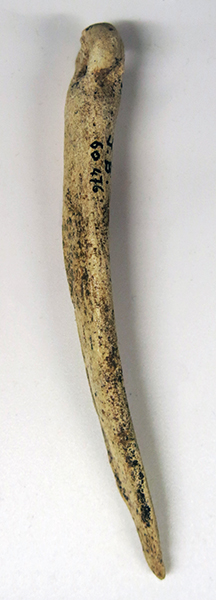
Poinçon, bone awl, Les Jean-Blancs (Jamblancs), Bayac (24).
( These are used for making holes in soft materials such as leather - Don )
Period: Solutrean
Bone, Inv. no. 60.476.170
Photo: Don Hitchcock 2015
Source: Original, Musée d'Aquitaine à Bordeaux

Lissoir, Les Vachons, Voulgézac (16).
( The slender, curved implements called lissoirs were shaped from (often) deer ribs and used to work animal hides to make them softer, tougher and more waterproof. The tools exploit particular features of bone, such as its toughness and flexibility. Lissoirs could not be made from a hard and brittle material like stone, because it would damage the leather and risk snapping in the user's hand. But made from bone, the tool would flex as it was pressed onto a hide.
Note that there are two ancient breaks which have had their ends eroded by various soil biota during the length of time they were buried, as well as two modern, clean breaks, probably occurring during excavation - Don )
Period: Solutrean
Bone, Inv. no. 60.253
Photo: Don Hitchcock 2015
Source: Original, Musée d'Aquitaine à Bordeaux
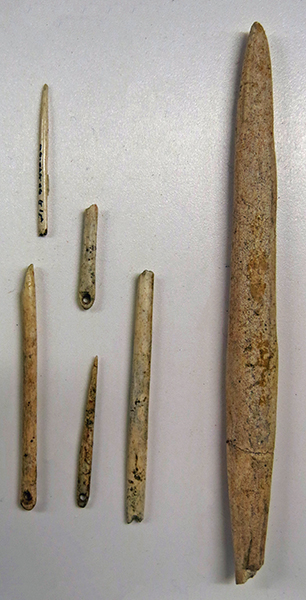
Needles and a spear head, Les Jean-Blancs (Jamblancs), Bayac (24).
Period: Solutrean
Bone, Inv. no. 60.476.57 to 60.476.61 (needles) and 60.476.174 (spear head)
Photo: Don Hitchcock 2015
Source: Original, Musée d'Aquitaine à Bordeaux

Solutrean bone Poinçon or awl for making holes in leather from Laugerie Basse.
Dimensions: length 87 mm, width 13 mm, thickness 4 mm.
Catalog: MAN54023.3
Photo: Don Hitchcock 2015
Source: Original, Musée d'Archeologie Nationale et Domaine, St-Germain-en-Laye
Text: https://www.photo.rmn.fr

Solutrean bone Poinçon or awl for making holes in leather from la grotte du Placard.
Dimensions: length 73 mm, width 8 mm, thickness 7 mm.
Catalog: MAN54023.3
Photo: Don Hitchcock 2015
Source: Original, Musée d'Archeologie Nationale et Domaine, St-Germain-en-Laye
Text: https://www.photo.rmn.fr
References
- Breuil H., 1909: L'Aurignacien présolutréen, épilogue d’une controvers, Revue préhistorique, 4, 8-9, p. 5-46.
- Combier J., 1955: Les fouilles de 1907 à 1925. Mise au point stratigraphique et typologique, in M. Thoral, R. Riquet et J. Combier (dir.), Solutré, Mâcon, éd. Faculté des Sciences de Lyon, Travaux du laboratoire de géologie de la faculté des Sciences de Lyon, nouvelle série 2, p. 93-220.
- Combier J., Montet-White A., 2002: Solutré 1968-1998, Paris, éd., Société préhistorique française, (Mémoire 30), pp. 281.
- Connet N. et al., 2005: L’occupation aurignacienne de Solutré (Crôt-du-Charnier et Terre-Sève ; 71) : les données de la fouille 2004, Rapport final d’opération, Inrap, Dijon, DRAC de Bourgogne, pp. 122.
- Floss H. et al., 2013: Le Paléolithique supérieur ancien en Bourgogne du sud, ResearchGate, Chapter, January 2013, DOI: 10.15496/publikation-11934
- Osborn H., 1919: Men of the Old Stone Age: Their Environment Life and Art, Library of Alexandria, 1919, 559 pages
- Pestle et al., 2006: AMS dating of a recently rediscovered juvenile human mandible from Solutré (Saône-et-Loire, France), Paleo, 18 | 2006, p. 285-292
- Sonneville-Bordes, D. et Perrot J., 1956: Lexique typologique du Paléolithique Supérieur, Bulletin de la Société Préhistorique française, 53, fascicule 9, p. 547-560, fig.
- Verry P. et al., 2009: Des paysages à voir et à lire en Bourgogne, Educagri Editions, 2009 - Bourgogne (France) / Descriptions et voyages - 176 pages
- Yelkrokoyade, 2009: Vue du village de Solutré-Pouilly - Saône et Loire (71), France, Wikimedia Commons. This file is licensed under the Creative Commons Attribution-Share Alike 1.0, 2.0, 2.5, 3.0 licenses.
Back to Don's Maps
 Back to Archaeological Sites
Back to Archaeological Sites
